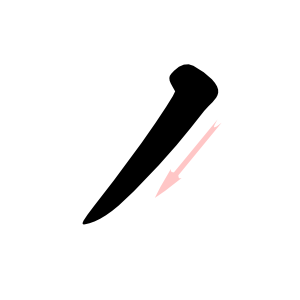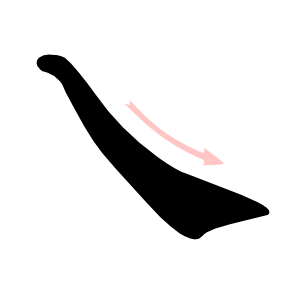Eight Principles of Yong on:
[Wikipedia]
[Google]
[Amazon]
The Eight Principles of ''Yong'' are used by calligraphers to practice how to write the eight most common
 ,
, style="text-align:center", S
,
,
,
,
, Downward
, -
!scope="row", 4
,
,
, style="text-align:center", S
,
,
,
,
, Downward
, -
!scope="row", 4
,  ,
, style="text-align:center", G
,
,
,
,
, Appended to others, suddenly going down, or left only
, -
!scope="row", 5
,
,
, style="text-align:center", G
,
,
,
,
, Appended to others, suddenly going down, or left only
, -
!scope="row", 5
,  ,
, style="text-align:center", T
,
,
,
,
, Flick up and rightwards
, -
!scope="row", 6
,
,
, style="text-align:center", T
,
,
,
,
, Flick up and rightwards
, -
!scope="row", 6
,  ,
, style="text-align:center", W
,
,
,
,
, Tapering thinning curve, usually concave left (convex outward right) with fast speed as if skimming
, -
!scope="row", 7
,
,
, style="text-align:center", W
,
,
,
,
, Tapering thinning curve, usually concave left (convex outward right) with fast speed as if skimming
, -
!scope="row", 7
,  ,
, style="text-align:center", P
,
,
,
,
, Falling leftwards with light curve
, -
!scope="row", 8
,
,
, style="text-align:center", P
,
,
,
,
, Falling leftwards with light curve
, -
!scope="row", 8
,  ,
, style="text-align:center", N
,
,
,
,
, Falling rightwards, fattening at bottom, where endpoint is "sharp as a knife"
,
, style="text-align:center", N
,
,
,
,
, Falling rightwards, fattening at bottom, where endpoint is "sharp as a knife"
File:Vĩnh tự bát pháp.jpg, The principles, as shown in the Vietnamese book (1851), with their individual strokes
File:Page 41 of Ngũ vân lâu tăng đính tứ thể thư pháp.jpg, A section in (1848), explaining the concept of the Eight Principles of ''Yong''
File:Vĩnh tự bát pháp.png, The Eight Principles of ''Yong'' depicted the calligraphy book, (1869)
stroke
Stroke is a medical condition in which poor cerebral circulation, blood flow to a part of the brain causes cell death. There are two main types of stroke: brain ischemia, ischemic, due to lack of blood flow, and intracranial hemorrhage, hemor ...
s in regular script
The regular script is the newest of the major Chinese script styles, emerging during the Three Kingdoms period , and stylistically mature by the 7th century. It is the most common style used in modern text. In its traditional form it is the t ...
, using the fact that they are all present in the character . It was believed that the frequent practice of these principles as such when beginning one's study could ensure beauty in the Chinese calligrapher's writing.
The Eight Principles are influenced by the Eastern Jin-era ''Seven Powers'' () by Lady Wei Shuo. Publications on the principles include:
* The Tang-era ''Praise to the Eight Principles of "Yong"'' () by Liu Zongyuan
* The Tang-era ''Praise to the Eight Principles of "Yong"'' () by Yan Zhenqing
* The Yuan-era
The Yuan dynasty ( ; zh, c=元朝, p=Yuáncháo), officially the Great Yuan (; Mongolian language, Mongolian: , , literally 'Great Yuan State'), was a Mongol-led imperial dynasty of China and a successor state to the Mongol Empire after Div ...
''Eight Ways to Explain "Yong"'' () by Li Puguang, which provides two-character metaphorical names
Table
} , zh, c=玉案, p=yù'àn, l=jade table, labels=no , zh, t=橫, first=t, s=横, p=héng, l=horizontal, labels=no , , Rightward , - !scope="row", 3 , ,
, style="text-align:center", S
,
,
,
,
, Downward
, -
!scope="row", 4
,
,
, style="text-align:center", S
,
,
,
,
, Downward
, -
!scope="row", 4
,  ,
, style="text-align:center", G
,
,
,
,
, Appended to others, suddenly going down, or left only
, -
!scope="row", 5
,
,
, style="text-align:center", G
,
,
,
,
, Appended to others, suddenly going down, or left only
, -
!scope="row", 5
,  ,
, style="text-align:center", T
,
,
,
,
, Flick up and rightwards
, -
!scope="row", 6
,
,
, style="text-align:center", T
,
,
,
,
, Flick up and rightwards
, -
!scope="row", 6
,  ,
, style="text-align:center", W
,
,
,
,
, Tapering thinning curve, usually concave left (convex outward right) with fast speed as if skimming
, -
!scope="row", 7
,
,
, style="text-align:center", W
,
,
,
,
, Tapering thinning curve, usually concave left (convex outward right) with fast speed as if skimming
, -
!scope="row", 7
,  ,
, style="text-align:center", P
,
,
,
,
, Falling leftwards with light curve
, -
!scope="row", 8
,
,
, style="text-align:center", P
,
,
,
,
, Falling leftwards with light curve
, -
!scope="row", 8
,  ,
, style="text-align:center", N
,
,
,
,
, Falling rightwards, fattening at bottom, where endpoint is "sharp as a knife"
,
, style="text-align:center", N
,
,
,
,
, Falling rightwards, fattening at bottom, where endpoint is "sharp as a knife"
CJK strokes
In addition to these eight common strokes in , there are at least two dozen strokes of combinations which enter in the composition of CJK strokes and by inclusion theCJK characters
In internationalization, CJK characters is a collective term for graphemes used in the Chinese, Japanese, and Korean writing systems, which each include Chinese characters. It can also go by CJKV to include Chữ Nôm, the Chinese-origin lo ...
themselves. Most strokes are encoded in Unicode
Unicode or ''The Unicode Standard'' or TUS is a character encoding standard maintained by the Unicode Consortium designed to support the use of text in all of the world's writing systems that can be digitized. Version 16.0 defines 154,998 Char ...
as symbols, to be used in ideographic description sequences (IDS). The standard characters names assigned in the UCS for these CJK strokes are based on initials of the modern Chinese names (romanized with Pinyin) of component principles with which they are recognized and drawn.
Gallery
See also
*CJK characters
In internationalization, CJK characters is a collective term for graphemes used in the Chinese, Japanese, and Korean writing systems, which each include Chinese characters. It can also go by CJKV to include Chữ Nôm, the Chinese-origin lo ...
* CJK strokes
References
{{DEFAULTSORT:Eight Principles Of Yong Cultural lists Chinese character strokes East Asian calligraphy